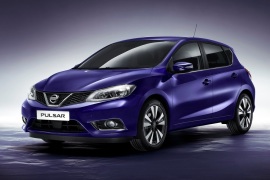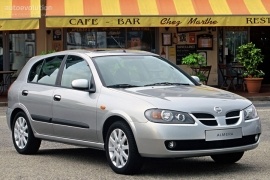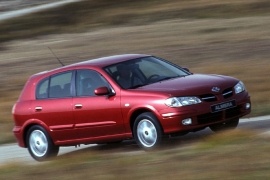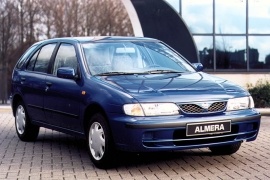NISSAN Almera / Pulsar 5 Doors Models/Series Timeline, Specifications & Photos
First production year: 1995
Engines: Gasoline, Diesel
Body style: Hatchback
The 2014 Nissan Pulsar was a hatchback built by Nissan for some selected market. It was a compact-sized hatchback with a long wheelbase and economic engines.
The Pulsar name was like a boomerang for the Nissan brand. It was used since the late '70s, but not on all the markets around the world. In some markets, it was also known as Sunny or Tiida. But the 2014 model was known mostly as Pulsar around the world. It was based on Nissan's CMF (Common Module Family) platform, which was used from small vehicles up to SUVs.
The compact hatchback design featured the known V-shaped chromed lines on the grille, with somehow aggressive styling. The front shaped bumper featured three air-scoops, with the largest one in the middle. A sculptured profile with ascending lines and the boomerang-style taillights defined the car's look. A small roof-spoiler was placed on top of the tailgate and it included the third stop-light.
Inside, there was a simple, yet modern, dashboard with two analog dials on the instrument cluster and a TFT display between them. The infotainment unit was placed on the center console and it looked like it was installed as aftermarket equipment and it was connected to the steering wheel buttons. An interesting waved, the design was featured on the dashboard. Due to an unusually long wheelbase for a car of its size, the Pulsar offered decent legroom for the rear passengers. In fact, at the time of its launch, it had the longest wheelbase in its class.
Under the hood, the Pulsar dropped the hot-hatch version with 200 hp from its previous generation and kept the economic ones of 1.2-liter gasoline and 1.5-liter diesel. They came as standard with manual transmissions, but an option of CVT was available.
Nissan introduced the second generation of the Almera in 2000 under different names, depending on the market, and improved it with a mid-life cycle refresh after just two years.
It was a new era for the Japanese carmaker who formed a close relationship with the French carmaker Renault. The newly created Renault-Nissan Alliance brought together technologies and platforms shared between the two big brands. The Almera was built on Nissan's MS platform, also used for its larger brother, the Primera.
The facelifted version brought improvements on the exterior with a clear-lens over the headlights and a redesigned bumper, which sported round fog lights. In the back, Nissan changed the taillights' design and adopted circular patterns for the brake and reversing lamps instead of rectangular ones installed on the non-facelifted version.
Inside, the change continued with a completely redesigned dashboard that sported a new instrument cluster with the speedometer and tachometer placed in the middle and flanked by the fuel-gauge on the left and coolant temperature on the right. Depending on the trim level and options, the 2002 Almera featured an integrated navigation system installed on top of the redesigned center stack.
Under the hood, Nissan received a 1.5-liter turbo-diesel engine carried over from the Renault parts bin. The top-of-the-range 2.2-liter turbo-diesel engine was paired to a six-speed manual gearbox.
Nissan designed the second generation of the Almera/Pulsar in Europe, and it proved to be easier to sell to European customers.
After Renault and Nissan formed the Alliance, the exchanged technologies helped both carmakers to offer better or improved products. The 2000 Almera/Pulsar relied on a Nissan platform, which was very good. With some know-how from its French partner, the Japanese carmaker created a successful compact five-door vehicle. After all, Renault was the inventor of the modern hatchback with the 1965 R16 model. Nissan created a car designed around the driver and focused on a family.
Its rounded design was a reminiscence of the bio-design era but enriched with a few sharp angles on the front grille that belonged to the new-edge-design trend. Its corner-mounted turn signals with clear glass and yellow bulbs made the car looks sportier. It was more of a family-friendly vehicle in the five-door shape, suitable for stress-free parking in crowded European cities, and comfortable enough for long journeys.
Inside, the curved lines dominated the dashboard. Only the navigation screen (offered as an option) and the center vents featured squared lines. In the instrument panel, the speedometer took the center stage flanked by the tachometer on the left and the fuel and coolant-temperature gauges on the right. The bucket seats were designed more for comfort and provided little bolstering. Its back seats featured a split-folding seatback and provided enough elbow and hip room but limited legroom for adult passengers. For children, on the other hand, it was excellent and featured ISOFIX points for child seats.
Under the hood, Nissan installed a choice of own or Renault-sourced turbo-diesel and gasoline engines. It paired them with a five-speed manual and an option for a four-speed automatic for the 1.8-liter version.
Nissan decided to change its compact-segment contender and traded the Sunny name with the Almera or Pulsar, depending on the market.
The Japanese carmaker design team was not in its best mood when it designed the five-door Almera. Its bland styling was truly different than other compact hatchbacks from the market, but not necessarily in a good way. It looks like Nissan relied more on the car's qualities more than its appearance.
At the front, the Almera showed a similar front fascia as the Primera P10 generation with horizontal headlights and a small grille between them that sported the Nissan logo at its upper side. The bumper featured an additional center grille crossed by a slat extended from side to side over the fake side air intakes. From its sides, the Almera featured a third glass area behind the rear doors, with an arched C-pillar. Thus, Nissan could install the same doors like those from the Almera sedan. In the back, the carmaker installed wide taillights split between the rear quarter panels and the tailgate.
Inside, the bland design continued with a simple, curved dashboard and a low profiled instrument cluster that hosted two larger dials for the speedometer and tachometer, plus the gauges for the fuel level and the coolant temperature. On the center stack, Nissan placed the audio system above the climate control unit. In the back, the split-folding seatback allowed the owner to increase the trunk size.
Under the hood, Nissan offered the Almera a choice of four engines and paired them with a standard five-speed manual transmission. The 1.6-liter gasoline unit was available with a four-speed automatic as an option.



